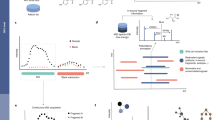Abstract
Tandem mass spectrometry using precursor ion selection (MS/MS) is an invaluable tool for structural elucidation of small molecules. In non-targeted metabolite profiling studies, instrument duty cycle limitations and experimental costs have driven efforts towards alternate approaches. Recently, researchers have begun to explore methods for collecting indiscriminant MS/MS (idMS/MS) data in which the fragmentation process does not involve precursor ion isolation. While this approach has many advantages, importantly speed, sensitivity and coverage, confident assignment of precursor–product ion relationships is challenging, which has inhibited broad adoption of the technique. Here, we present an approach that uses open source software to improve the assignment of precursor–product relationships in idMS/MS data by appending a dataset-wide correlational analysis to existing tools. The utility of the approach was demonstrated using a dataset of standard compounds spiked into a malt-barley background, as well as unspiked human serum. The workflow was able to recreate idMS/MS spectra which are highly similar to standard MS/MS spectra of authentic standards, even in the presence of a complex matrix background. The application of this approach has the potential to generate high quality idMS/MS spectra for each detectable molecular feature, which will streamline the identification process for non-targeted metabolite profiling studies.






Similar content being viewed by others
References
Bern, M., Finney, G., Hoopmann, M. R., Merrihew, G., Toth, M. J., & MacCoss, M. J. (2010). Deconvolution of mixture spectra from ion-trap data-independent-acquisition tandem mass spectrometry. Analytical Chemistry, 82, 833–841. doi:10.1021/Ac901801b.
Hakansson, K., Zubarev, R., & Hakansson, P. (1998). Combination of nozzle-skimmer fragmentation and partial acid hydrolysis in electrospray ionization time-of-flight mass spectrometry of synthetic peptides. Rapid Communications in Mass Spectrometry, 12, 705–711.
Hoopmann, M. R., Finney, G. L., & MacCoss, M. J. (2007). High-speed data reduction, feature detection and MS/MS spectrum quality assessment of shotgun proteomics data sets using high-resolution mass spectrometry. Analytical Chemistry, 79, 5620–5632. doi:10.1021/Ac0700833.
Horai, H., et al. (2010). MassBank: A public repository for sharing mass spectral data for life sciences. Journal of Mass Spectrometry, 45, 703–714. doi:10.1002/Jms.1777.
Ipsen, A., Want, E. J., Lindon, J. C., & Ebbels, T. M. D. (2010). A statistically rigorous test for the identification of parent-fragment pairs in LC–MS datasets. Analytical Chemistry, 82, 1766–1778. doi:10.1021/Ac902361f.
Li, L. J., et al. (2001). High-throughput peptide identification from protein digests using data-dependent multiplexed tandem FTICR mass spectrometry coupled with capillary liquid chromatography. Analytical Chemistry, 73, 3312–3322.
Loo, J. A., Udseth, H. R., & Smith, R. D. (1989). Peptide and protein-analysis by electrospray ionization mass-spectrometry and capillary electrophoresis mass-spectrometry. Analytical Biochemistry, 179, 404–412.
Loo, J. A., Edmonds, C. G., Udseth, H. R., & Smith, R. D. (1990). Collisional activation and dissociation of large multiply charged proteins produced by electrospray ionization. Analytica Chimica Acta, 241, 167–173.
Nesvizhskii, A. I., Vitek, O., & Aebersold, R. (2007). Analysis and validation of proteomic data generated by tandem mass spectrometry. Nature Methods, 4, 787–797. doi:10.1038/Nmeth1088.
Plumb, R. S., et al. (2006). UPLC/MSE; a new approach for generating molecular fragment information for biomarker structure elucidation. Rapid Communications in Mass Spectrometry, 20, 1989–1994. doi:10.1002/Rcm.2550.
Purvine, S., Eppel, J. T., Yi, E. C., & Goodlett, D. R. (2003). Shotgun collision-induced dissociation of peptides using a time of flight mass analyzer. Proteomics, 3, 847–850. doi:10.1002/pmic.200300362.
R Development Core Team. (2011). R: A language and environment for statistical computing.
Smith, C. A., Want, E. J., O’Maille, G., Abagyan, R., & Siuzdak, G. (2006). XCMS: Processing mass spectrometry data for metabolite profiling using nonlinear peak alignment, matching, and identification. Analytical Chemistry, 78, 779–787. doi:10.1021/Ac051437y.
Tautenhahn, R., Böttcher, C., & Neumann, S. (2007). Annotation of LC/ESI–MS mass signals. Bioinformatics Research and Development. In S. Hochreiter & R. Wagner (Eds.), Lecture notes in computer science (Vol. 4414, pp. 371–380). Berlin: Springer.
Theodoridis, G., Gika, H. G., & Wilson, I. D. (2011). Mass spectrometry-based holistic analytical approaches for metabolite profiling in systems biology studies. Mass Spectrometry Reviews, 30, 884–906. doi:10.1002/Mas.20306.
Wishart, D. S. (2011). Advances in metabolite identification. Bioanalysis, 3, 1769–1782. doi:10.4155/Bio.11.155.
Author information
Authors and Affiliations
Corresponding author
Electronic supplementary material
Below is the link to the electronic supplementary material.
Rights and permissions
About this article
Cite this article
Broeckling, C.D., Heuberger, A.L., Prince, J.A. et al. Assigning precursor–product ion relationships in indiscriminant MS/MS data from non-targeted metabolite profiling studies. Metabolomics 9, 33–43 (2013). https://doi.org/10.1007/s11306-012-0426-4
Received:
Accepted:
Published:
Issue Date:
DOI: https://doi.org/10.1007/s11306-012-0426-4




